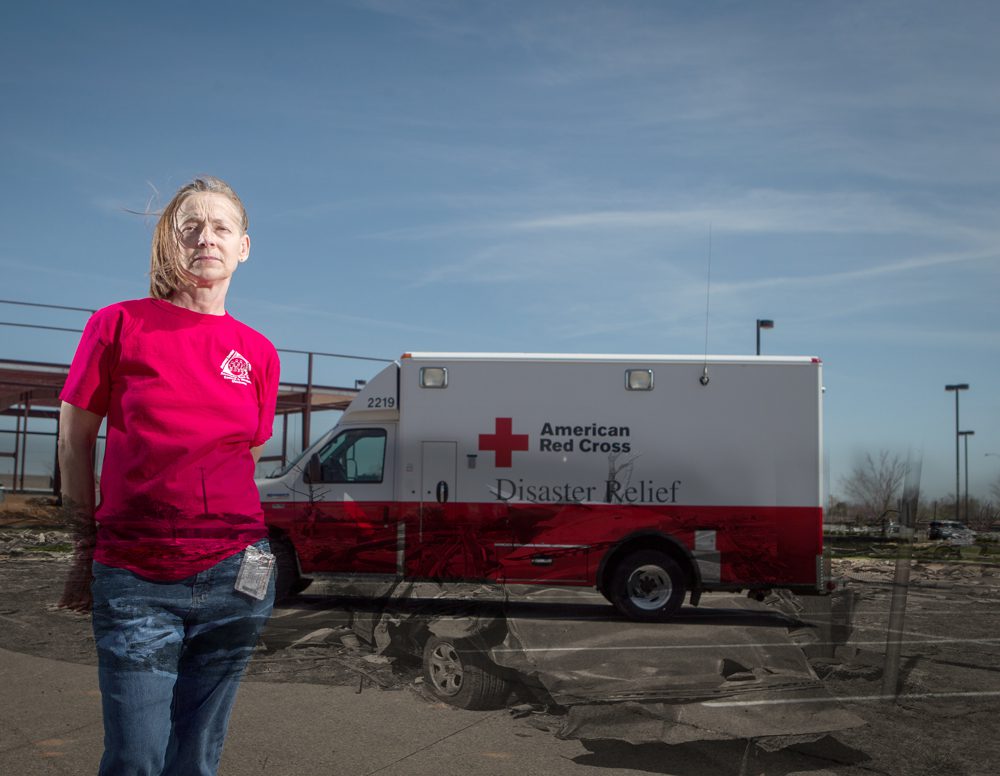
‘Their Eyes Are Always The Same’
Carla Young, regional mass care manager for the American Red Cross, says helping meet the needs of others puts joy in her heart. She began volunteering with the organization during the Oklahoma City bombing in 1995 and again during Hurricane Katrina in 2005. She is now a full-time volunteer.
“The phrase, ‘You get back more than you give,’ is not just a saying with the Red Cross,” Young says. “It is what happens when you volunteer with this amazing organization.”
On the morning of May 20, Young and her crew of volunteers were already in disaster-response mode. Just the day before, the towns of Luther and Shawnee had been terrorized by a tornado outbreak. The new day brought predictions of more severe weather. Young and the other volunteers were on a weather watch while coordinating trucks of supplies and volunteers, shelter and food for the towns devastated the previous day.
Like many Oklahomans that afternoon, Young watched the swift development of the super-cell thunderstorms – storms that were clearly headed for what Young calls “the Moore tornado path of the past.” She began calling her crews on the road, urging them to find a safe location out of the storm’s way. Cell phone service cut in and out before it cut off altogether, making it more difficult to reach the volunteers. Soon, she began to hear the sirens.
“I have to say every person working at the Red Cross office that day was in our Emergency Operation Center watching the TVs, because every person was affected in some way,” she says. “Not only were we worrying about our crews in the field, but we ourselves had to take cover in the storm safety room at the Red Cross office on Northeast Sixth Street, across from the University of Oklahoma Health Sciences Center.”
The tornado passed the Oklahoma City office, leaving it untouched. Young and her crew immediately began to coordinate relief efforts.
“We knew this storm was big, and we knew we needed every resource we had to cover the first few days of the response,” she says. “As soon as the May 20 storm passed, the city-county emergency incident command was set up. The Red Cross was called to support the first responders on the scene in the Moore area.”
Young sent emergency response vehicles loaded with snacks, water and coffee to the damaged areas and immediately opened shelters at St. Andrew’s United Methodist Church and the Moore Community Center.
“When Red Cross was let into the main destruction zone, I heard over and over that there were no roads, no road signs, no landmarks left to let any of the volunteer crews know where they were,” Young says. “I was told repeatedly it was easy to get lost in the maze of debris. What was so disheartening was that debris was someone’s personal effects, their cherished items, everything they owned before the storm.”
The most difficult part of the storm’s aftermath, Young says, were the eyes of the devastated.
“It’s always the eyes of the disaster clients that are the hardest to take. One day, I got out of the office and went to Moore to the feeding kitchen at the Baptist church,” she says. “I was stopped by so many people on the way in, just wanting to tell their story. You would think stories would be somewhat alike … what you find out during a disaster is every story and experience is different, and they need you to listen. But their eyes are always the same.”























